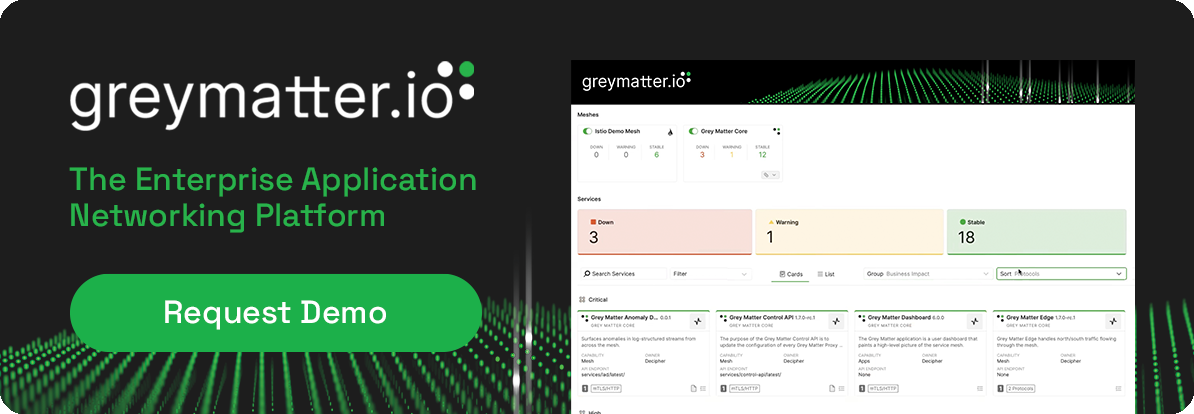blog
GitOps for API Management
Learn how GitOps automates API Management
without the complexity of an API Gateway

October 19, 2022
API management is critical to modern application development. It enables organizations to build or adopt outside APIs to meet developer and application requirements with speed and simplicity. Organizations have traditionally done this through the use of an API Gateway. However, the emergence of enterprise application networking platforms presents a more efficient way of performing API management on internal and external APIs that, when coupled with GitOps tools, allows the organization to perform the same functions as an API Gateway and much more. These benefits span both inner and outer architectures with expectations to reduce Time to Value (TtV), providing customers with an immediate return on time, money, and effort on new features.
The Traditional Approach
Traditional API management processes involved a development cycle, a deployment cycle, and an operation and maintenance cycle. Each step consists of its own manual process, which relies on separate teams, schedules, outage windows, and administrative responsibilities. Any disconnects between development and production teams can result in bottlenecks and delays in the deployment process, version confusion, and lack of standardization, leading to decreased productivity and delivery.
Many development teams are starting to migrate from a monolithic application stack to containerized architectures. Production team need to encrypt any and all communications between APIs, services and data sources connected across these new containerized architectures. Typically, this is done through firewall rules, hard-coded IP addresses, and load balancing. However, most of these methods do not scale well without some administrative intervention. Because production configuration files, automation tooling, and implementation documentation are often untracked, this often leads to unpredictable deployments and non-repeatability. As the product moves from development to production dependencies, configuration drift, and other deployment issues frequently occur.
Automate Everything
The combination of GitOps and enterprise application networking platforms deliver the automated management and control necessary to solve the challenges of traditional API management.
GitOps is an operational framework that applies DevOps best practices to infrastructure automation. It provides version control, change tracking, and automated movement from environment to environment. While GitOps might represent a cultural shift for some organizations, enterprises that do adopt these modern processes gain significant competitive advantage in agility, flexibility and scalability to accelerate software delivery and increase speed to market over less progressive industry competitors.
Enterprise application networking platforms leverage GitOps workflows to deliver automated scaling, traffic management, and access controls among a wide list of enterprise features. Such capabilities provide a unified platform for complexity management, zero-trust security, and operational insight, allowing enterprises to embrace a “deliver-first, manage-later” approach.
When applied together, these platforms provide a centralized working repository, enterprise application networking platform configurations, and valuable metrics collection to enable rapid responses to situations in your environment, as well as faster, more efficient scaling.
Improved Communications and Collaboration
Organizations that integrate development and operations teams benefit from streamlined communication, improved collaboration, strengthened security, enhanced productivity, and accelerated speed of delivery. DevOps and platform engineering teams are then able to combine application code and infrastructure-as-code into one, centralized Git repository, which ensure all changes are clear and concise for reviewing team members. As commits are pushed into a branch, CI pipelines run validations and tests on the changes that have been made. This process is not limited to infrastructure code, but is also used for application code as well. Once merged, triggers can then build the application, deploy containers, and apply configuration. This approach pairs nicely with a DevSecOps methodology to software development, ensuring security is baked into the testing infrastructure, achieving faster deployments and application delivery times.
Enhanced Traffic Security
An enterprise application networking platform is capable of properly securing traffic, whether East-West or North-South. When configurations are properly applied as an access control method, the platform is able to perform various traffic-shaping functions. These configurations can be used to prevent unauthorized user access to internal and external APIs, or even APIs that are part of your monetization strategy. These configurations can also be used to limit the amount of requests coming into an API, establish appropriate routes, and configure advanced load-balancing rules. Other features, such as testing blue/green deployments, are well within the scope of these configurations.
Illuminating Observables
Depending on the enterprise application networking platform provider, you will be able to obtain various observable data on API usage over time, such as who has been accessing the API, and even what information particular users are looking for in your data. Some enterprise application networking platform providers can also look into the environment of a service to glean container metrics. This vital information can be collected and aggregated into other tools, allowing you to visualize and analyze requests coming into your APIs, study potential patches, or inform API deprecation decisions.
Immediate Response
Rapid responses are sometimes needed to ensure API availability and integrity. Most enterprise application networking platform providers have a mechanism to edit configurations directly, allowing organizations to add restrictions, limits, and mitigation options, such as limiting the rate at which an API is accessed because of a flaw in the service deployment or the API itself. While this is a common production scenario, this can also lead to configuration drift. GitOps workflows can automatically revert these changes in the event of a misconfiguration, so it is important that normal processes must be followed to make these changes in-band once mitigation has been applied.
Conclusion
GitOps makes infrastructure automation possible, allowing DevOps and platform engineering teams to increase productivity, reliability, and responsiveness. Enterprise application networking platforms that include solid GitOps workflows allow organizations to successfully deploy API management, security, and observability capabilities to any environment. Administrators, developers, and SOC/NOC analysts can leverage these capabilities to gain operational insights into API usage, service metrics, and data flows to provide further oversight and guidance to senior leadership on application development, delivery, and performance.

